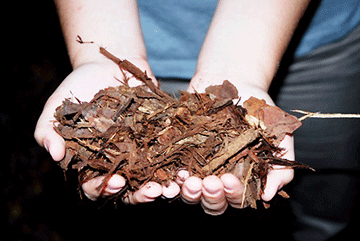
Volume XVII, Issue 23 # June 4 - June 1, 2009 |
 |
by Dr. Frank Gouin
 If You Must Mulch …
If You Must Mulch …
Here’s how to do it right
Since I last wrote about problems associated with mulching and over-mulching, readers, including Cindy Wallace, have asked for more information what to use, when and how to apply it.
The primary purpose for mulch is aesthetics. A covering of mulch adds the final finish to a landscape. The second contribution of mulch is reducing water lost by evaporation. The third and least effective use of mulch is weed control. If you are using mulch to control weeds, you are applying too much. Mulch controls weeds by suffocation. If you are suffocating weeds, you are most likely suffocating the roots of shallow-rooted plants.
I have never purchased a bag of mulch in my life. In the fall, I rake as many leaves as possible under the branches of shrubs. The rest of the leaves are composted and applied as mulch in the flower and vegetable garden.
If I were to purchase mulch, I would only purchase shredded pine bark mulch. Shredded pine bark mulch contains the most lignins, which decompose slowly and do not leave high levels of manganese as a residue. If I were to apply pine bark mulch, I would not exceed a depth of one inch. Research has repeatedly shown that it only takes an inch of mulch to prevent water lost by evaporation. That is also an adequate amount to be aesthetically pleasing.
A single application of pine bark mulch can last you two to three years. All you need to do is use a steel rake to fluff the existing mulch. If that is not adequate, you should always remove the old mulch before placing new mulch. By doing so, you minimize the chances of suffocating the roots due to the accumulative effect of repeated mulching.
During my 30 years as extension specialist in ornamental horticulture, I covered the entire state of Maryland many times and saw repeated problems associated with over-mulching. More ornamentals are killed by either over-mulching or using poor-quality mulch than by any other cause.
Tree Trimmings as Mulch
Q I recently read your article in Bay Weekly about mulch. thank you so much! Great info.
We recently had a partially dead, very large maple tree cut down from our yard and have a very large pile of shredded mulch. Can I use this in my gardens? I hate to see it go to waste.
There are also chips from dead limbs cut from an oak tree. Is it safe to use that mulch?
–Cindy Wallace: Program Coordinator, South River Federation
A Ground wood is not mulch. If you apply fresh-ground wood as a mulch, it will suck the nutrients out of the soil, and your plants will starve. You can use fresh-ground wood in making paths, and it will starve out the weeds. Wood waste does not make safe mulch for use around ornamentals unless it has been composted.
Ground wood can be converted to mulch by blending in six pounds of urea nitrogen fertilizer per cubic yard of wood chips and keeping it moist and turning the pile every three weeks. If you are faithful, you will have mulch in about six months.